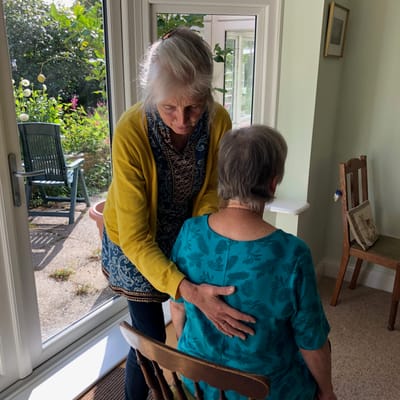Alexander Technique
Jenny Brown MSTAT
Twickenham
What Is The Alexander Technique?
F.M. Alexander (1869-1955) was born in Tasmania. He made a career for himself giving recitations of the works of Shakespeare. He developed voice problems, which caused hoarseness and loss of voice during recitations. He followed doctors' advice and rested before performances.
As Alexander's problems did not improve he started to work on himself to find a solution. He used mirrors to observe himself during ordinary speaking and when reciting. He found that when he was reciting he pulled his head back, depressed his larynx and sucked in breath through his mouth. In time he noticed that he also shortened in stature.
Alexander experimented for months and finally found a way of changing his use of himself which allowed him to recite without losing his voice. He realised that he needed to prevent habits of use which were harmful, and use his head, neck and back in a way which allowed him to function effectively.
Alexander developed skill in diagnosing harmful use in individuals. He worked on people using simple procedures, e.g. sitting down and getting up from a chair, standing. Doctors sent patients whom they were unable to treat effectively. Alexander helped people with a range of ailments including indigestion, sciatica, poor circulation and angina pectoris, as well as so called "nervous and mental troubles" (The Use of The Self pp60)
Image Credit: https://en.wikipedia.org/wiki/F._Matthias_Alexander

About lessons



Performers find that the Technique helps with voice production and movement.
People who work at desks with computers find that the Technique helps to alleviate back, neck and shoulder pain.
People who suffer from repetitive strain injury, joint pain and other painful conditions get relief from Alexander Technique lessons.
People who feel stressed find that the Technique helps them to relax and develop calmness.
Athletes find that they develop stamina and improve their performance.
What is involved in having an Alexander lesson ?
Simple procedures are used in the lesson. These include standing, sitting down, and walking, as well as table work. The pupil is encouraged to use less muscular effort when moving. The teacher uses his/her hands to guide the pupil through movements. Verbal instructions are given and the use of Alexander's "directions" encouraged.
The aim of the lesson is to encourage the pupil to stop harmful habitual patterns of behaviour and to use the body more efficiently. Using the body more efficiently puts less strain on the joints and vital organs. The teacher aims to raise the pupil's level of self-awareness.
How many lessons are recommended ?
Between 20 and 30 lessons are recommended, although this is not prescriptive. Weekly lessons are recommended.
Testimonials
- I was I a car accident in my mid twenties in which my face went through the windscreen. That was the beginning of some physical problems, which included frequent headaches.
What the Alexander Technique has done for me is to act as a reminder to allow my back, and in my case especially my neck, to lengthen. It helps free up the joints from undue strain.
By practising the technique one learns to retrain the body quite naturally.
Annie R.
- I started Alexander Technique to improve my postural position after spinal injury. I was struggling to get back to being physically comfortable and knew that my posture was the main reason for this.
I describe the Alexander Technique, as a gentle series of positions that the body learns are the best ones for you. In many ways the learning is unconscious as it taps into your body's muscle memory and reminds me of the Chi work that underpins martial arts (perhaps this is a bit esoteric for some people). Through breath you relax and I enjoy my weekly sessions and they are a way for me to tune out of the rest of my life. In terms of posture, I am definitely more aware of my body position when walking and sitting, etc. and I am striding to embed this in all movements. It is slow but worthwhile and a good long-term way to improve posture. It also makes you realise that most of the furniture you come across is no good for you!
Helen C.
- I was diagnosed with Costochrondritis in November 2013. I went to see a Rheumatologist who recommended the Alexander Technique. Since I started classes 6 months ago, there has been a huge improvement with my chest pain and I feel my aches and pains have reduced dramatically. Jenny is very patient and gently encourages the correct movements. She is able to give a sense of how the ability to stop, think and consciously free our movement can help regain the natural balance that gets lost over years of bad habits. Jenny is always looking for new ways in which the Alexander Technique can be used and enjoys sharing this knowledge. She is an enthusiastic teacher who obviously gets great pleasure from helping people.
CW
About Jenny Brown
Jenny completed a three-year training course at The Constructive Teaching Centre in London form 2006-2009. She is a member of the Society of Teachers of the Alexander Technique. She gives private lessons at her home in Twickenham.
Jenny trained as a social worker in her twenties and continues to work part time in the local Social Services Department. She has found that the Alexander Technique has proved to be "a tool for living" as it has provided balance to the demands of statutory work.
She enjoys gardening, walking and cycling. She also enjoys visiting art galleries and exhibitions.
Recommended reading
Barlow, W. The Alexander Principle. (1990) Arrow.
Gelb, M. Body Learning: An Introduction to the Alexander Technique. (1987) Aurum Press.
Useful website. The Society of Teachers of the Alexander Technique. www.stat.org.uk.
Contact
- 11 South Road, Twickenham, UK